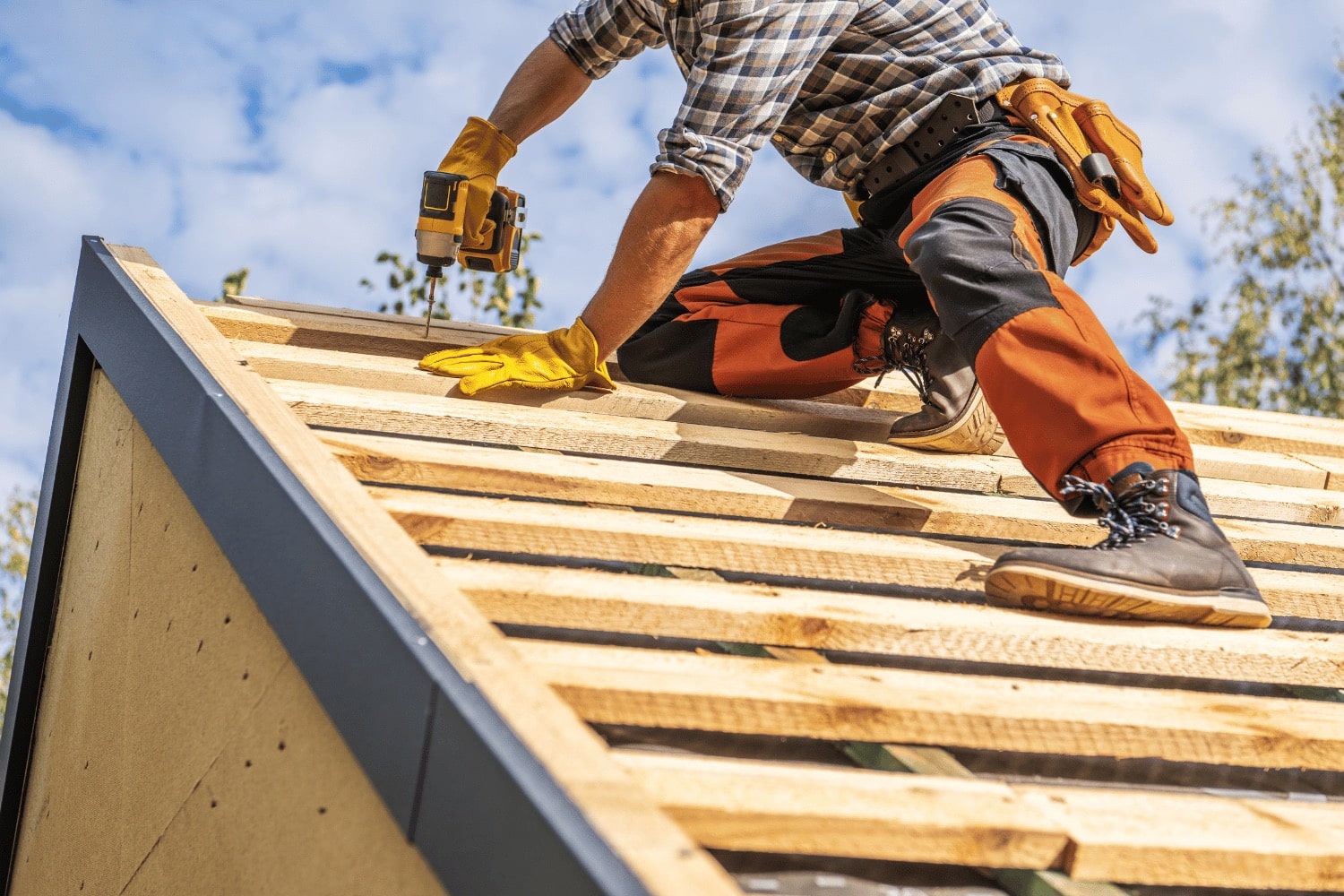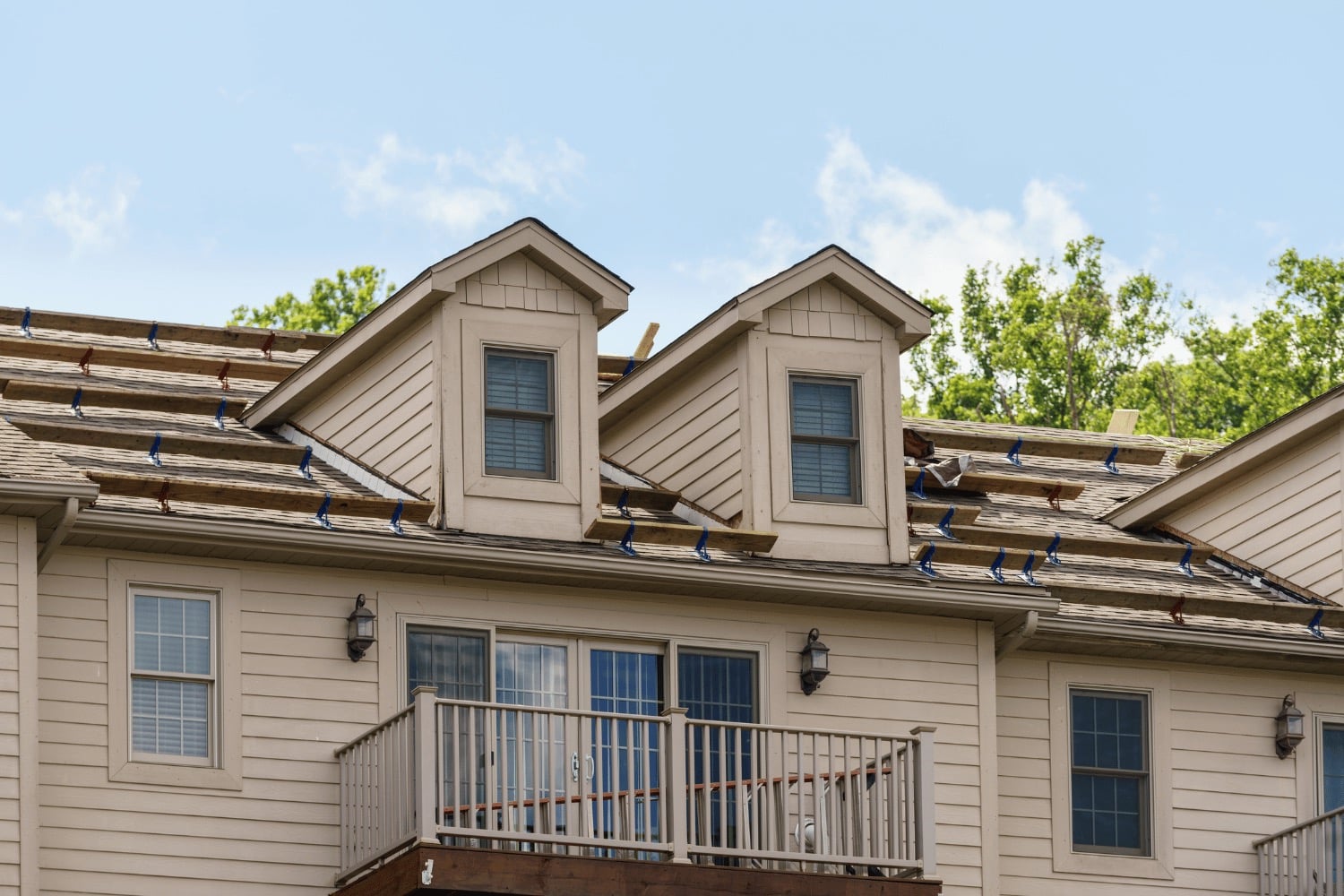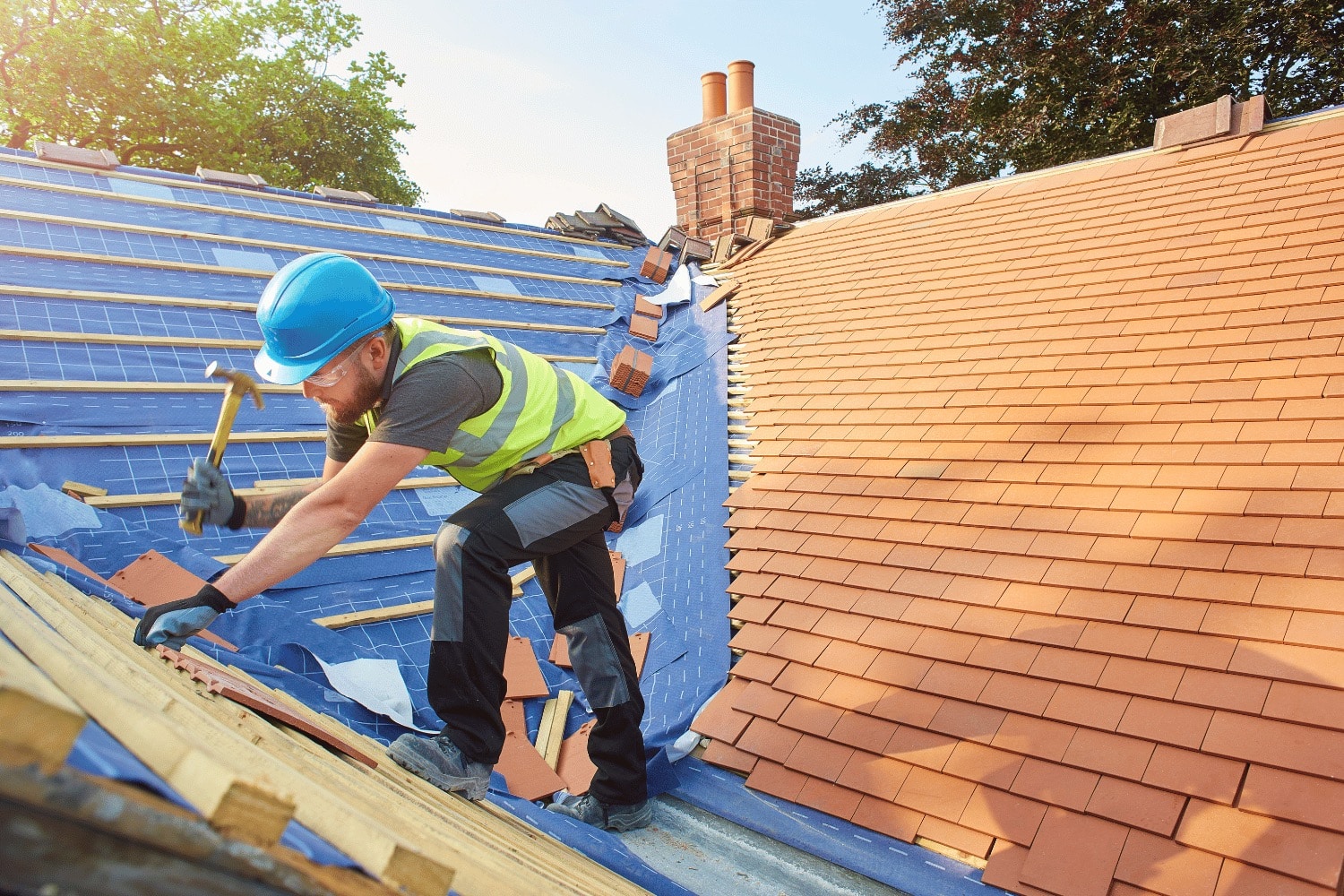The Ultimate Guide to Roof Replacement Costs (2024)
Considering a roof replacement? Discover the factors that affect costs, learn the signs it’s time for a new roof, and find out how to choose the right roofing material. This guide will help you plan and budget effectively.
Key Takeaways
-
Roof replacement costs are influenced by size, materials, labor, location, and permitting fees, with the national average ranging from $7,000 to $24,000.
-
Choosing the right roofing material is crucial for durability, energy efficiency, and climate suitability, with options like asphalt shingles, metal roofs, and tile/slate each having distinct advantages and drawbacks.
-
Hiring a professional roofing contractor offers safety and quality assurance for roof replacements, while DIY approaches carry risks that may lead to costly errors and safety hazards.
Understanding Roof Replacement Costs

When it comes to roof replacement, several factors can significantly impact the overall cost. The size, slope, and material requirements of your roof are primary considerations. Understanding these variables can help homeowners budget effectively and avoid surprises.
Approximately 40% to 50% of total roof replacement costs are allocated to materials, making them a substantial part of the equation. Labor costs, often constituting up to 60% of the total expense, also play a crucial role. Location and permitting fees also fluctuate, influencing the final bill. For example, replacing a 1,000-square-foot roof costs between $4,700 and $10,000, influenced by the mentioned factors.
The national average cost for a full roof replacement typically falls between $7,000 and $24,000, with most homeowners spending around $15,159 to $27,580 for a new roof. These figures can vary based on specific choices and conditions in each case.
Roofing Materials
Roofing materials significantly impact replacement costs. Common options include asphalt shingles, wooden shakes, slate tiles, metal roofs, and concrete roofs, each with unique characteristics and price points. Asphalt shingles, for instance, are budget-friendly and typically cost around $11,500 for a 1,500-square-foot home. They require periodic maintenance and may not suit extreme climates.
On the other hand, materials like metal roofs can last up to 70 years and offer better performance in harsh weather conditions. Local climate and regional preferences greatly impact material durability and maintenance.
Labor Costs
Labor costs are another significant factor in the overall roof replacement cost. Labor costs range from $2 to $7 per square foot, influenced by roof design complexity and contractor experience. For instance, steeper roofs and those with complex designs demand more time and skill, leading to higher labor fees.
Labor costs increase in high living expense areas or for hard-to-access jobs. While opting for a DIY roof replacement might seem like a way to save money, it comes with significant risks and potential for costly errors.
Location and Permitting
Geographic location significantly affects roof replacement costs. Material prices and labor rates vary across regions, influenced by local market conditions. Additionally, building permits, which can cost between $75 and $250, are often required for roof replacements and should be factored into the overall budget.
These permits ensure that the roofing work complies with local building codes and standards.
Signs You Need a Roof Replacement

Identifying roof replacement signs can prevent costly future repairs. One of the most obvious indicators is missing or damaged shingles, which can lead to leaks and further damage to your home’s structure. Granules in gutters or bald shingle spots indicate aging, suggesting it’s time for a new roof.
The age of your roof is another important factor. Most roofs last between 20 to 30 years, depending on the material. If your roof is approaching this age, it’s wise to start planning for a replacement. Additionally, curled edges, cupped tabs, and cracked shingles are all signs of wear that indicate the need for a new roof.
Moss growth on the roof is also a warning sign. Moss can trap moisture against the shingles, leading to potential damage over time. Addressing these issues promptly with the help of a professional roofing contractor can prevent more severe problems and protect your home.
Choosing the Right Roofing Material
Choosing the right roofing material impacts cost and longevity. Key factors to consider include the material’s durability, energy efficiency, and suitability for your local climate. For instance, metal roofs are highly recommended for cold climates due to their performance in snow, while asphalt shingles might be more economical but require more upkeep in such conditions.
In hot climates, materials like metal, clay, and stone are ideal as they reflect heat and have less thermal expansion. Each material comes with its own set of benefits and drawbacks, making it essential for homeowners to research and choose the right roofing material for their specific needs.
Asphalt Shingles
Asphalt shingles are a popular choice due to their affordability and ease of installation. They are lightweight and customizable, making them suitable for a variety of home styles. However, they require maintenance every few years and may not be ideal for hot climates as they are prone to cracking under extreme temperatures.
Despite drawbacks, asphalt shingles are cost-effective for many homeowners.
Metal Roofing
Metal roofing is known for its durability and energy efficiency. It can last between 40 to 70 years and offers resistance to fire, cracking, and erosion. However, some metal roofing options can be costly and may be prone to rusting if not properly maintained.
The long-term benefits of metal roofs often justify the higher initial cost.
Tile and Slate Roofing
Tile and slate roofing are highly durable and aesthetically pleasing options. They offer exceptional resistance to rot and require low maintenance. However, the installation of tile roofing is complex and can be more expensive due to the skilled labor required.
These materials are particularly suitable for hot climates and coastal regions where their durability can be maximized.
The Roof Replacement Process

The roof replacement process involves several critical steps, starting with a thorough inspection to assess the current roof’s condition. This is followed by the removal of the old roof, which requires professional contractors to ensure proper identification and resolution of any underlying issues. The installation of the new roof comes next, where safety precautions and quality workmanship are paramount.
The entire process typically spans three to four days, including cleanup and disposal of old materials. Knowing each step helps homeowners prepare and ensure a smooth replacement.
Initial Inspection
A thorough initial inspection assesses the roof’s condition and determines replacement steps. During this inspection, elements such as visible damage, mold growth, and interior water stains should be carefully examined. Identifying issues like missing shingles, leaks, and excessive granules in gutters can indicate that a roof replacement may be necessary.
This detailed inspection can reveal underlying problems that may lead to costly repairs if ignored.
Removal of Old Roof
Removing the old roof is labor-intensive, costing $1 to $5 per square foot. Homeowners who choose to remove their old roof themselves may incur additional costs for junk removal, which can be as much as $600.
Replacing damaged roof decking, often discovered at this stage, can increase expenses. Structural repairs to elements like rafters or trusses can add between $500 and $5,000 to the total cost, depending on the severity of the damage.
Installation of New Roof
New roof installation includes laying the underlayment and installing the roofing material. Complex designs with multiple penetrations, such as skylights and chimneys, can increase labor costs. These special features require additional materials and skilled labor to ensure proper installation.
The underlayment is critical as it protects the roof deck against water infiltration and acts as a barrier against wind and other elements.
DIY vs. Professional Roof Replacement

Homeowners often choose between DIY roof replacement or hiring a professional contractor. While DIY might seem like a cost-saving option, it comes with significant risks and potential for costly errors. On the other hand, hiring a professional ensures quality workmanship, safety, and warranty coverage.
DIY roof replacement risks include safety hazards and potential home damage.
Hiring a professional roofing contractor offers quality workmanship, safety, and warranty coverage. Homeowners should weigh the risks of DIY against the benefits of hiring a professional to make an informed decision about roof replacement.
Risks of DIY Roof Replacement
Without proper training and equipment, individuals attempting roof work face a high risk of falling, which is a leading cause of home-related injuries. Mistakes made during a DIY roof replacement can lead to significant issues, such as not addressing underlying problems that result in costlier repairs later.
Project complexity requires tool and ladder experience; errors may lead to hiring a contractor to redo work, adding costs.
Benefits of Hiring a Professional Roofing Contractor
Hiring a licensed roofing company ensures safety and quality during roof replacement projects. Professional roofing contractors follow proper safety precautions and use safety materials to minimize risk while working on roofs. Experienced roofers can clarify what is included in their quotes and ensure that all aspects of the job, such as the removal of existing shingles and replacement of damaged sheathing, are handled correctly.
Professional roofing contractors offer enhanced safety, quality workmanship, and peace of mind.
Financing Your Roof Replacement
Financing a roof replacement can make the expense more manageable. Various lenders, including banks, credit unions, and specialized home improvement financing companies, offer financing options. These can range from home equity loans to lines of credit, each providing relief and manageable payment plans for unexpected costs.
Knowing the different financing options is crucial. Home equity loans and lines of credit are common methods, allowing homeowners to borrow against the equity in their property and typically offering lower interest rates compared to personal loans. This makes them attractive choices for financing significant home improvements like roof replacement.
Payment Plans and Loans
Home equity loans and lines of credit are popular financing options for roof replacements. These allow homeowners to borrow against their property’s equity, often with lower interest rates compared to personal loans.
These options offer financial relief and flexibility, easing roof replacement costs. Financing options can be particularly beneficial for homeowners faced with unexpected roofing expenses.
Insurance Coverage
Roof replacement insurance coverage varies by policy and replacement reason. Some policies cover the full cost of a new roof, not just depreciated value.
Homeowners should carefully review their insurance policy and speak with their insurance agent to understand their coverage and ensure qualification before filing a claim.
Additional Cost Factors
When budgeting for a roof replacement, consider additional costs like permit fees, inspections, and related work fees. Removing an old roof typically costs $1 to $5 per square foot. Protecting the property by covering landscaping and using specialized equipment for debris disposal is an essential initial step.
After removing the old roof, any damaged sheathing needs to be replaced to ensure a solid base for the new roofing. Factor these additional costs into your overall budget.
Structural Repairs
A thorough inspection checks for water damage in the existing sheathing before replacement. Structural repairs, like fixing rafters or trusses, can significantly increase roof replacement costs. These repairs ensure the integrity of the roof structure and prevent future issues.
Skylights and Chimneys
Skylights and chimneys can increase roof replacement costs due to additional labor requirements and materials. Skylight replacement typically costs $800 to $2,200. Factors such as the size of the roof and the new materials required also contribute to the overall cost.
Cleanup and Disposal
Disposal fees for old roofing materials can greatly impact total roof replacement cost. These fees can range from $100 to $1,000, depending on the volume and type of materials removed. Cleanup and disposal usually cost $50 to $500, depending on the method.
This step is critical for ensuring that the work site is left clean and safe.
Choosing a Roofing Contractor

Selecting a reputable roofing contractor ensures a smooth and successful roof replacement. Verify licenses, insurance, and certifications to ensure the contractor is qualified and legal. Not using a licensed contractor can lead to voiding the roof or home warranty. Homeowners should carefully evaluate potential contractors to ensure they are licensed, insured, and provide quality work.
Choosing the right contractor involves researching reviews, checking references, and comparing quotes. This due diligence ensures you select a contractor capable of high-quality, industry-standard work.
Checking Credentials
Verifying a contractor’s credentials ensures they are qualified for the work. Check for a C-39 license, required for roofing contractors. A reputable contractor should provide proof of licenses, insurance, and certifications upon request.
Confirm the contractor holds appropriate state home improvement licenses.
Reading Reviews and References
Reading reviews and checking references ensures trustworthiness and evaluates service quality. Platforms like the Better Business Bureau, Trustpilot, Yelp, and Reddit offer valuable customer insights.
These reviews help homeowners assess the quality of service provided by the roofing contractors.
Getting Multiple Quotes
Getting multiple quotes allows effective comparison of pricing and services. Always get estimates from several contractors before selecting one. Requesting liability insurance and workers’ compensation certificates ensures protection and professionalism.
Assessing past work by requesting photos of completed projects is beneficial.
Summary
Understanding the roof replacement cost involves considering various factors, including materials, labor, location, and additional costs. Recognizing when a roof replacement is necessary and choosing the right materials and contractors can significantly impact the overall experience and cost. Financing options and insurance coverage can help manage expenses, while selecting a reputable contractor ensures quality and peace of mind. By being well-informed, homeowners can navigate the roof replacement process confidently and effectively.
Frequently Asked Questions
What are the main factors influencing roof replacement costs?
The main factors influencing roof replacement costs are roofing materials, labor costs, geographic location, permit fees, and any additional features such as skylights and chimneys. Understanding these elements can help you anticipate and budget for your roof replacement effectively.
How can I finance my roof replacement?
To finance your roof replacement, consider utilizing home equity loans, lines of credit, or specific home improvement financing options. These methods can effectively help you manage the associated costs.
What signs indicate that I need a roof replacement?
Key indicators that you need a roof replacement include missing or damaged shingles, a roof age of over 20 years, curled edges, granules in gutters, and the presence of moss growth. Addressing these signs promptly can prevent further damage to your home.
Why should I hire a professional roofing contractor?
Hiring a professional roofing contractor ensures quality workmanship and safety while providing warranty coverage, minimizing risks and potential costs associated with DIY work.
How can I choose the right roofing material for my home?
To choose the right roofing material for your home, you should evaluate local climate, durability, energy efficiency, and maintenance requirements. This comprehensive approach will ensure you make an informed decision that meets your needs.


 Residential Roofing
Residential Roofing Storm Damage
Storm Damage Multi-Family Homes
Multi-Family Homes
